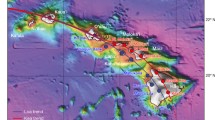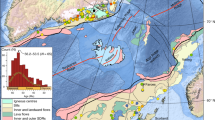Abstract
The large-scale geometry and age progression of many hotspot island chains, such as the Hawaiian–Emperor chain, are well explained by the steady movement of tectonic plates over stationary hotspots. But on a smaller scale, hotspot tracks are composed of discrete volcanic islands whose spacing correlates with lithospheric thickness1. Moreover, the volcanic shields themselves are often not positioned along single lines, but in more complicated patterns, such as the dual line known as the Kea and Loa trends of the Hawaiian islands2, 3. Here we make use of the hypothesis that island spacing is controlled by lithospheric flexure1 to develop a simple nonlinear model coupling magma flow, which feeds volcanic growth, to the flexure caused by volcanic loads on the underlying plate. For a steady source of melt underneath a moving lithospheric plate, magma is found to reach the surface and build a chain of separate volcanic edifices with realistic spacing. If a volcano is introduced away from the axis of the chain, as might occur following a change in the direction of plate motion, the model perpetuates the asymmetry for long distances and times, thereby producing an alternating series of edifices similar to that observed in the Kea and Loa trends of the Hawaiian island chain.


Similar content being viewed by others
References
Ten Brink, U. Volcano spacing and plate rigidity. Geology 19, 397–400 (1991).
Jackson, D. E., Silver, E. A. & Dalrymple, G. B. Hawaiian-Emperor chain and its relation to Cenozoic circumpacific tectonics. Geol. Soc. Am. Bull. 83, 601–618 (1972).
Tatsumoto, M. Isotopic composition of lead in oceanic basalts and its implications to mantle evolution. Earth Planet. Sci. Lett. 38, 63–87 (1978).
Olson, P. in Magma Transport and Storage (ed. Ryan, M. P.) 33– 51 (Wiley, New York, (1990)).
Schubert, G., Olson, P., Anderson, C. A. & Goldman, P. Solitary waves in mantle plumes. J. Geophys. Res. 94 , 9523–9532 (1989).
Skilbeck, J. N. & Whitehead, J. A. Formation of discrete islands in linear island chains. Nature 272, 499–501 (1978).
Ihinger, P. D. Mantle flow beneath the Pacific plate; evidence from seamount segments in the Hawaiian-Emperor chain. Am. J. Sci. 295, 1035–1057 (1995).
Vogt, P. R. Volcano spacing, fractures, and thickness of the lithosphere. Earth Planet. Sci. Lett. 21, 235–252 (1974).
Turcotte, D. L. & Schubert, G. Geodynamics (Wiley, New York,(1982)).
Guillou, H., Garcia, M. O. & Turpin, L. Unspiked K-Ar dating of young volcanic rocks from Loihi and Pitcairn hot spot seamounts. J. Volcan. Geotherm. Res. 78, 239–249 (1997).
Lister, J. R. & Kerr, R. C. Fluid-mechanical models of crack propagation and their application to magma transport in dykes. J. Geophys. Res. 96, 10049–10077 (1991).
Rubin, A. M. Propagation of magma filled cracks. Annu. Rev. Earth Planet. Sci. 23, 287–336 ( 1995).
Bruce, P. M. & Huppert, H. E. in Magma Transport and Storage (ed. Ryan, M. P.) 87–101 (Wiley, New York, (1990)).
Lister, J. R. & Dellar, P. J. Solidification of pressure-driven flow in a finite rigid channel with application to volcanic eruptions. J. Fluid Mech. 323, 267–283 (1996).
Davies, G. F. Thermomechanical erosion of the lithosphere by mantle plumes. J. Geophys. Res. 99, 15709–15722 (1994).
Wessel, P. Observational constraints on models of the Hawaiian hot spot swell. J. Geophys. Res. 98, 16095–16104 (1993).
Kohlstedt, D. L., Evans, B. & Mackwell, S. J. Strength of the lithosphere: Constraints imposed by laboratory experiments. J. Geophys. Res. 100, 17587–17602 (1995).
Bonatti, E. Not so hot “hot spots” in the oceanic mantle. Science 250, 107–111 ( 1990).
Burnham, C. W. in The Evolution of the Igneous Rocks (ed. Yoder, H. S.) 439– 482 (Princeton Univ. Press, (1979).
Eiler, J. M., Farley, K. A., Valley, J. W., Hofmann, A. W. & Stolper, E. M. Oxygen isotope constraints on the sources of Hawaiian volcanism. Earth Planet. Sci. Lett. 144, 453–468 (1996).
Garcia, M. O. Petrography and olivine and glass chemistry of lavas from the Hawaii Scientific Drilling Project. J. Geophys. Res. 101, 11701–11713 (1996).
Watts, A. B. An analysis of isostasy in the world's oceans: 1. Hawaiian-Emperor seamount chain. J. Geophys. Res. 83, 5989– 6004 (1978).
Wessel, P. Areexamination of the flexural deformation beneath the Hawaiian swell. J. Geophys. Res. 98, 12177–12190 (1993).
Jackson, E. D. & Shaw, H. R. Stress fields in central portions of the Pacific plate: Delineated in time by linear volcanic chains. J. Geophys. Res. 80, 1861– 1874 (1975).
Hauri, E. H. Major-element variability in the Hawaiian mantle plume. Nature 382, 415–419 ( 1996).
Wessel, P. & Kroenke, L. Ageometric technique for relocating hotspots and refining absolute plate motions. Nature 387, 365–369 (1997).
Canuto, C., Hussaini, M. Y., Quarteroni, A. & Zhang, T. A. Spectral Methods in Fluid Dynamics (Springer, New York, ( 1988)).
Jaeger, J. C. & Cook, N. G. W. Fundamentals of Rock Mechanics 3rd edn 190–191 (Chapman & Hall, London, (1979)).
Swanson, D. A. Magma supply rate at Kilauea volcano, 1952–1971. Science 175, 169–170 ( 1972).
Acknowledgements
We thank N. Ribe, A. Rubin and Y. Ricard for helpful comments. This work was supported by the NSF.
Author information
Authors and Affiliations
Corresponding author
Rights and permissions
About this article
Cite this article
Hieronymus, C., Bercovici, D. Discrete alternating hotspot islands formed by interaction of magma transport and lithospheric flexure. Nature 397, 604–607 (1999). https://doi.org/10.1038/17584
Received:
Accepted:
Issue Date:
DOI: https://doi.org/10.1038/17584
- Springer Nature Limited
This article is cited by
-
Mantle plumes and their role in Earth processes
Nature Reviews Earth & Environment (2021)
-
Cascading parallel fractures on Enceladus
Nature Astronomy (2019)
-
The concurrent emergence and causes of double volcanic hotspot tracks on the Pacific plate
Nature (2017)
-
Seismic imaging of melt in a displaced Hawaiian plume
Nature Geoscience (2013)
-
Geochemical zoning of volcanic chains associated with Pacific hotspots
Nature Geoscience (2011)





